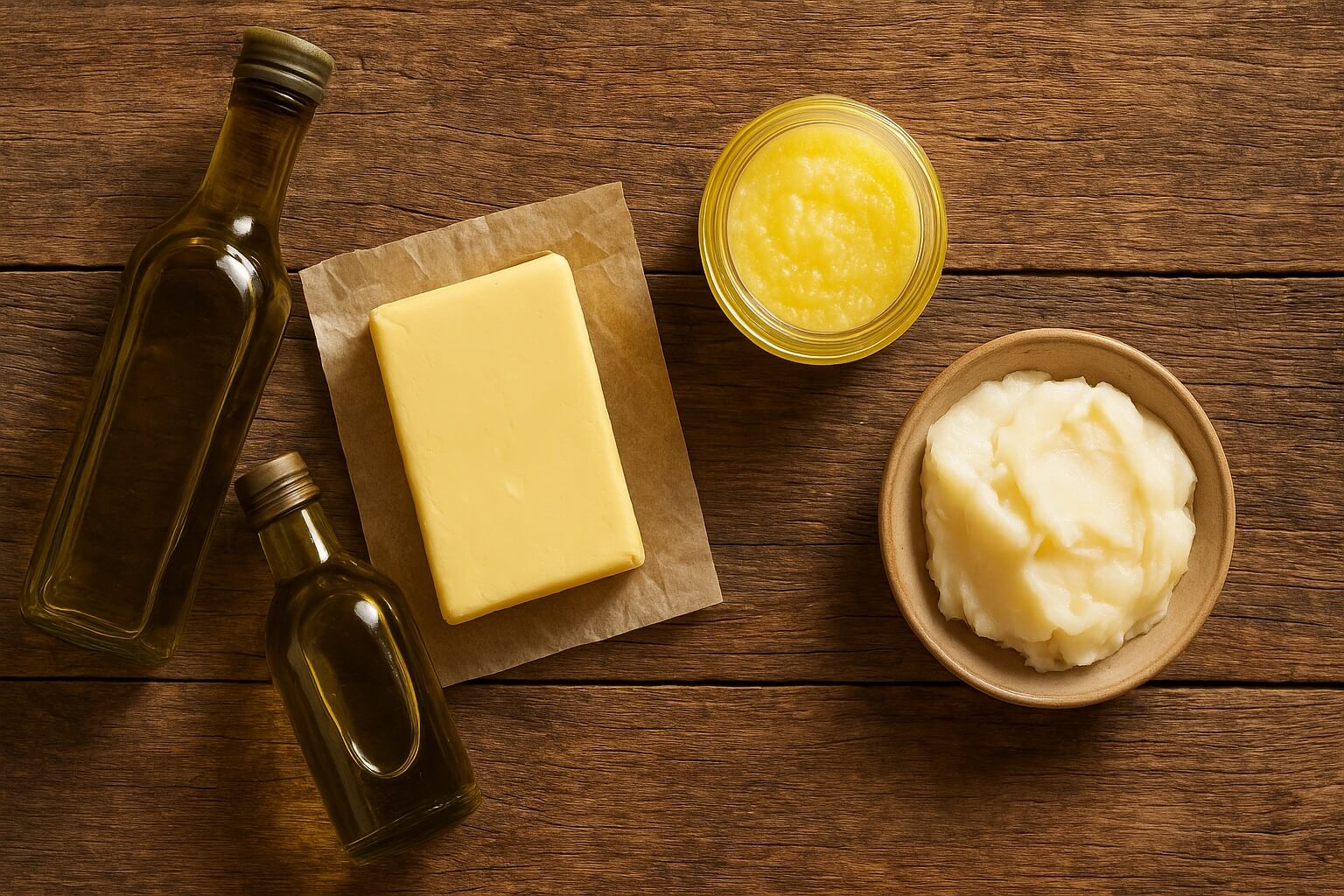Fats in Cooking: Oils, Butter, Lard, and More
Fats are essential in cooking. They carry flavor, affect texture, and make dishes satisfying. Choosing the right fat — whether it’s olive oil, butter, ghee, or lard — can completely change the outcome of your recipe. Understanding when and why to use different fats helps you cook smarter and more confidently.

Why Fats Matter
- Flavor – butter adds richness, olive oil adds fruitiness, lard adds depth
- Texture – fats influence tenderness in baked goods, crispness in frying, and creaminess in sauces
- Cooking performance – smoke point determines how a fat behaves under heat
- Nutrition – fats provide energy, essential fatty acids, and help absorb vitamins
Plant-Based Oils
Olive Oil
Olive oil is one of the most versatile and widely used oils. It comes in several types:
- Extra-virgin olive oil (EVOO) – cold-pressed, fruity, strong flavor, best for dressings, drizzling, or low to medium heat cooking
- Virgin olive oil – slightly lower quality, milder flavor, still good for everyday cooking
- Refined olive oil – neutral taste, higher smoke point, better for frying
- Light olive oil – blended, lighter in flavor and color, often used in baking
👉 Tip: Use EVOO for flavor and finishing, refined olive oil for high-heat cooking.
Other Common Oils
- Canola and sunflower oil – neutral taste, high smoke point, good for frying
- Avocado oil – high smoke point (over 250 °C / 480 °F), excellent for searing and grilling
- Peanut oil – traditional in Asian stir-fries and deep frying
- Coconut oil – solid at room temperature, adds sweetness; better in baking or curries
Animal Fats
Butter
Butter is beloved for its flavor and baking properties.
- Best for: sauces, sautéing, and baking
- Limitations: lower smoke point (~175 °C / 350 °F), burns easily at high heat
Ghee (Clarified Butter)
Ghee is butter with milk solids removed.
- Benefits: higher smoke point (~230 °C / 450 °F), longer shelf life, nutty flavor
- Best for: frying, roasting, and Indian cooking
Lard
Rendered pork fat, once a staple in baking and frying.
- Benefits: very high smoke point, neutral yet savory flavor
- Best for: pie crusts, biscuits, and traditional fried foods
Tallow
Rendered beef or lamb fat.
- Benefits: rich, meaty flavor, excellent stability for frying
- Best for: roasting potatoes, frying, and adding depth to stews
Duck Fat
Duck fat is prized for its luxurious flavor and versatility.
- Benefits: medium-high smoke point (~190 °C / 375 °F) and a rich, silky texture
- Best for: crispy potatoes / french fries, confit, sautéed vegetables, and roasting poultry
- Tip: Often sold in jars or tubs, duck fat keeps well in the fridge and adds restaurant-level flavor to simple dishes like fries or roast potatoes.
When and Why to Use Each
- High-heat searing/grilling – avocado oil, refined olive oil, ghee, tallow
- Flavor finishing – extra-virgin olive oil, butter, ghee, duck fat
- Baking – butter (for flavor), lard (for flakiness), oils (for moisture)
- Deep frying – peanut oil, canola, tallow, or lard for stability
- Potatoes & fries – duck fat or beef tallow for crispness and unbeatable flavor
- Everyday cooking – olive oil and butter remain kitchen staples
Storage Tips
- Oils – store in a cool, dark place. Olive oil keeps 12–18 months unopened, ~6 months after opening.
- Butter – refrigerate up to 1 month, freeze for longer storage.
- Ghee – shelf-stable for months in a sealed jar; refrigerate to extend life.
- Lard and tallow – store in airtight containers in the fridge or freezer to prevent rancidity.
- Duck fat – refrigerate after opening; can be frozen to extend shelf life.
Conclusion
Fats are more than just fuel — they shape the way food tastes, cooks, and feels. By knowing the differences between oils, butter, ghee, lard, tallow, and duck fat, you’ll know exactly when to reach for olive oil for its fruity bite, butter for rich sauces, or duck fat for world-class fries. Mastering fats is one of the simplest ways to cook better at home.